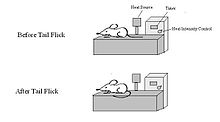Tail flick test
The tail-flick test is used in animal experiments to quantify pain reactions (to heat). It is used, for example, when a painkiller is being tested for its effectiveness. It was first described by D'Amour and Smith in 1941.
It is carried out by heating the tail of a test animal up to the pain threshold . The time it takes for the animal to move its tail is measured.
Experimental set-up
Various devices were developed to carry out the experiment, in which, for example, a heating resistor gives off constant heat and thus heats the animal's tail. The examiner then measures the length of time that elapses between switching on the current and the movement of the tail.
Application and limits
The test is used, for example, when testing the effect of drugs on the pain threshold. It is often used on rats after they have been given painkillers to test the effects of the drug. The temperature of the skin is essential for the result of the test. The critical temperature that leads to (avoidance) movement of the tail also seems to be dependent on its temperature at the beginning of the investigation. If the tail was cooled before the examination, the critical temperature also drops. Genetic disposition also plays a role in the result, at least in mice. For example, it was found that the Calca gene is essentially responsible for the generation of pain caused by heat.
The test is one of the numerous examination procedures that aim to quantitatively map pain stimuli (here on heat) in living organisms. As a rule, it provides usable results for showing the pain threshold under different conditions (for example after medication has been administered). Nevertheless, it should be noted that the results cannot be transferred to humans without criticism, as these do not necessarily react to pain in the same way as mice or rats . Many thermal tests like this also let it not, between pure opioid - agonist and mixed agonist-antagonist to differ, which is why the analogue use of refrigeration on the tail of the animals has been studied.
swell
- ↑ Fred E. D'Amour, Donn L. Smith: A method for determining loss of pain sensation. . In: J Pharmacol Exp Ther 72, 1941, pp. 74-78.
- ↑ TM Tzschentke, T. Christoph et al .: (-) - (1R, 2R) -3- (3-dimethylamino-1-ethyl-2-methyl-propyl) -phenol hydrochloride (tapentadol HCl): a novel mu-opioid receptor agonist / norepinephrine reuptake inhibitor with broad-spectrum analgesic properties. In: The Journal of pharmacology and experimental therapeutics. Volume 323, Number 1, October 2007, pp. 265-276, ISSN 0022-3565 . doi : 10.1124 / jpet.107.126052 . PMID 17656655 .
- ↑ T. O'Dell, L. Wilson et al .: Pharmacology of a series of new 2-substituted pyridine derivatives with emphasis on their analgesic and interneuronal blocking properties. In: The Journal of pharmacology and experimental therapeutics. Volume 128, January 1960, pp. 65-74, ISSN 0022-3565 . PMID 14428053 .
- ↑ K. Doebel, A. Gagneux: Certain Imidazolone Derivatives and Process for Making Same. US patent 3,303,199, 1965 [1]
- ↑ S. Irwin, RW Houde et al. a .: The effects of morphine methadone and meperidine on some reflex responses of spinal animals to nociceptive stimulation. In: The Journal of pharmacology and experimental therapeutics. Volume 101, Number 2, February 1951, pp. 132-143, ISSN 0022-3565 . PMID 14814606 .
- ↑ C. Fender, M. Fujinaga, M. Maze: Strain differences in the antinociceptive effect of nitrous oxide on the tail flick test in rats. In: Anesthesia and analgesia. Volume 90, Number 1, January 2000, pp. 195-199, ISSN 0003-2999 . PMID 10625003 .
- ↑ RP RAND, AC BURTON, T. ING: The Tail of the Council, Temperature Regulation and acclimatization. In: Canadian Journal of Physiology and Pharmacology . Volume 43, March 1965, pp. 257-267, ISSN 0008-4212 . PMID 14329334 .
- ^ OG Berge, I. Garcia-Cabrera, K. Hole: Response latencies in the tail-flick test depend on tail skin temperature. In: Neuroscience letters. Volume 86, Number 3, April 1988, pp. 284-288, ISSN 0304-3940 . PMID 3380319 .
- ↑ Jeffrey S. Mogil: The Surprising Complexity of Pain Testing in the Laboratory Mouse. ( Memento of the original from November 13, 2013 in the Internet Archive ) Info: The archive link was automatically inserted and not yet checked. Please check the original and archive link according to the instructions and then remove this notice. (PDF; 215 kB) 2007, pp. 11–23.
- ↑ XJ Chen, EN Levedakou et al. a .: Proprioceptive sensory neuropathy in mice with a mutation in the cytoplasmic Dynein heavy chain 1 gene. In: The Journal of neuroscience: the official journal of the Society for Neuroscience. Volume 27, Number 52, December 2007, pp. 14515-14524, ISSN 1529-2401 . doi : 10.1523 / JNEUROSCI.4338-07.2007 . PMID 18160659 .
- ↑ D. Le Bars, M. Gozariu, SW Cadden: Animal models of nociception. In: Pharmacological reviews. Volume 53, Number 4, December 2001, pp. 597-652, ISSN 0031-6997 . PMID 11734620 . (Review).
- ↑ RJ Pizziketti, NS Pressman u. a .: Rat cold water tail-flick: a novel analgesic test that distinguishes opioid agonists from mixed agonist-antagonists. In: European journal of pharmacology. Volume 119, Numbers 1-2, December 1985, pp 23-29, ISSN 0014-2999 . PMID 2867920 .
